Araz Agha , Abdussalam Shibani , Dyaa Hassan , Alexander Salmon
School of Energy, Construction and Environment, Coventry University, Coventry, CV1 5FB, United Kingdom
Correspondence to: Araz Agha , School of Energy, Construction and Environment, Coventry University, Coventry, CV1 5FB, United Kingdom.
| Email: |  |
Copyright © 2020 The Author(s). Published by Scientific & Academic Publishing.
This work is licensed under the Creative Commons Attribution International License (CC BY).
http://creativecommons.org/licenses/by/4.0/

Abstract
The United Kingdom is currently facing a housing shortage and has been for many years, caused mostly by natural growth in population, immigration and an aging housing stock. The solution to combat this problem is not as simple as constructing many hundreds of thousands of homes across the country, with many setbacks caused by economic, environmental and social concerns. The design and planning of individual residential projects, with fundamentally sustainable schemes could help to mitigate the concerns that are causing setbacks to house building. Building Research Establishment Environmental Assessment Methodology (BREEAM) is the world’s longest established method of assessing, rating and certifying the sustainability of buildings produced by Building Research Establishment (BRE). Implementing BREEAM on construction projects can vastly increase their sustainability compared to those that simply follow regulations. Projects that follow BREEAM specifications covered any additional costs by lower running costs during the building’s life. Providing people in the UK with homes which are built in a highly sustainable manner may allow huge benefits that outweigh the costs for both of the residents and the wider population. The general knowledge and consciences of people is also increasing for a more sustainable world, and as construction can contribute but also take away greatly from the sustainability of society, this approach to building seems obvious and yet is nowhere near mainstream as one may expect. This study looks to investigate the reasons behind a low proportion of BREEAM implementation on residential projects, when at first glance the benefits seem to greatly outweigh the costs. Secondary data gathered through a desk study was used to help determine the costs and benefits of residential projects that have implemented BREEAM. The researcher also attempted to gather primary data in the form of interviews and a questionnaire, gaining an insight into a current construction industry view on the usage of BREEAM.
Keywords:
BREEAM, BRE, Sustainability, Residential projects
Cite this paper: Araz Agha , Abdussalam Shibani , Dyaa Hassan , Alexander Salmon , Building Research Establishment Environmental Assessment Methodology on the UK Residential Projects, International Journal of Construction Engineering and Management , Vol. 9 No. 6, 2020, pp. 183-189. doi: 10.5923/j.ijcem.20200906.01.
1. Introduction
Surrounding the subject of BREEAM specifically generally fell into a three different but notable categories. The first category of literature comprises comparisons between BREEAM and other environmental assessment methodologies, most notably LEED as the other prominent assessment methodology, and how they are used. The second was analysis of BREEAM, how effective it is, how it affects the projects that it is used on and the wider construction industry. This was mostly based on the performance factors of BREEAM and covered highly quantitative research into the mechanisms of BREEAM, also case studies of BREEAM would fall into this category. The third category of research was found was information regarding the relationship between BREEAM and the construction industry. They explored how construction professionals regard BREEAM and what experience they have had with it. All three categories do see some cross-over as elements of each will undoubtedly occur, however it shows a distinct concentration of emphasis by different pieces of research.The first category of research is useful for trying to understand how BREEAM compares with other assessment methodologies and helps to show that BREEAM is at the forefront with LEED in terms of worldwide recognition. Going as far as being imported to other countries around the world [1] suggesting that ‘there are many other countries and regions where both BREEAM and LEED will expand their presence over the next decade as a result of both increased demand and active promotion… The analysis of the two databases has confirmed the increasing widespread use of BREEAM and LEED internationally.’ This may suggest that BRE is approaching their expansion on a more international stage for the generation of revenue and recognition rather than a complete monopoly on UK projects, and slowing the widespread implementation in the UK. Comparisons between BREEAM, LEED, CASBEE and Green Star NZ (BREEAM and LEED more so) have shown that a comparison can be made in environmental performance rather easily - with BREEAM certified buildings consuming 6 – 30% lower energy costs than non-certified buildings compared with LEED’s 18 – 39% lower energy costs [2].However, it is hard to make a direct comparison between BREEAM and LEED as these do not consider complete sustainability only environmental data as ‘a comprehensive comparison of tools has not been established’. According to Doan et al, (2017) [3] proving it may be problematic to make fair comparisons with BREEAM that are completely valid and not without bias to make a conclusion. As Vimpari and Junnila, (2014) [2] compare the four before mentioned methodologies through their influence, availability and prevalence rather than actual systematic like for like performance comparisons. The second category helps to develop an understanding of how BREEAM works and what cause and effect it has on the construction industry. This helps to go into more detail on the inner workings of BREEAM with plenty of information being provided by BRE. This is highly relevant to connect how the mechanism of BREEAM plays a part in the prevalence of its adoption by the construction industry. The effectiveness of BREEAM is shown by benefits that it can bring to the project with nearly 60% of client responses from BSRIA research Parker, (2012) agreeing that it reduces construction waste and materials usage, as well as improving occupancy satisfaction. The research also shows that the main benefit to BREEAM for contractors was in recognition and industry standing at 77%. This may show that although there are the obvious sustainability benefits to BREEAM, contractors’ value how the implementation of it is good for image and reputation over the environmental benefits [4]. However, the actual definite effectiveness of BREEAM is hard to ascertain and has been acknowledged as so [6]. So, while it may be easy to show the benefits of BREEAM according to contractors that have used it and in comparison, to projects that do not use it also, it is still technically difficult to define the true effectiveness of BREEAM to sustainability on a wider scale. The effects have also not been specifically explored in detail in the residential sector and most of the research conducted by BSRIA in ‘The Value of BREEAM’ [4] was for office use projects. Leaving a gap in the research into the residential area. Literature showing the relationship between the construction industry and BREEAM is lacking in number and seems to be a gap in literature. Although research has been conducted on contractors that do implement BREEAM not much seems to have been conducted for those that do not. An emphasis on the effect of BREEAM on clients and professionals can be shown that 96% of those surveyed in the BSRIA research would use BREEAM again, 88% would recommend it to others and interestingly 71% think that it is a good thing. This may further suggest that the use of BREEAM by contractors and clients is seen as a tool for increasing industry standing rather than for the cause of sustainability, possibly leading to the slow in widespread implementation to only those who are able to implement it. Ambiguity over the implementation and functions of BREEAM may be a cause of lack of universal uptake. A study consisting of interviews with seven clients, four of which had not used BREEAM before, showed that there was common non-professional understanding of BREEAM and that none interviewed felt that they had any understanding of the process [7]. It seems there is a gap in literature on the effect and influence of BREEAM over construction professionals and clients and more specifically with those that have not used BREEAM before. It is necessary that research be done into those that have not used BREEAM before but have a basic understanding of it and as to what their level of knowledge of BREEAM is and if that is a reason for non-implementation as instead of having sufficient knowledge but deciding not to use it. This study is to investigate and analyse the pros and cons of implementing BREEAM on residential projects in the UK, and what is hindering its universal implementation to help achieve highly sustainable house building across the UK.
2. Methodology
This paper will discuss the research methodologies and data collection approach that will be employed by the researcher for this study. This study will attempt to utilise mixed methodologies questionnaire and Interviews. As the results are objective in nature, they can be used to provide clear mathematical evidence, usually presented in the form of graphs, charts and tables.To collect pre-existing information on BREEAM and its standing within the UK construction industry, the literature review was utilised in this sense to ascertain a consensus and see what direction the research may take.A questionnaire was also used to provide quantitative results based on closed end questions answered by construction professionals to gauge the opinion and understanding of BREEAM. The questions were chosen to ascertain levels of awareness, effectiveness of previous experience, and for a voiced opinion at the end to add remarks for the purposes of this study. The first question asked the participant how long they had worked in the construction industry, as a matter of interest, but also to see if any correlation could be made between experience in the industry and opinion held of BREEAM. The main body of the questionnaire comprised 12 closed end questions, asking the participant to rank on a scale of 1 – 10 (as well as a non-applicable option for certain questions). Each question had the scaling explained with 1 generally being for the most negative response and 10 for the most positive response, to help further justify the results of the survey a score of lower than 5 could be considered a negative response and that above 5 a positive response. The scale of 1 to 10 also allows for a quick and easy conversion into a percentage opinion rating, allowing for analysis of the results to help ascertain opinion more clearly. The results were interpreted on this linear scale to give a more precise gauge on which to base opinionated results upon. At the end an open-ended question asking the participant on their opinion on BREEAM’s usage was also included. The questionnaire provided data from 15 participants working in the construction industry. Finally, Overall the following questions were asked and required an answer as part of the research investigations: 1) How long have you worked in construction Industry?2) How greatly do you feel the success of construction project is owned to it is economic performance?3) How greatly do you feel the success of construction project is owned to it is environmental performance?4) How greatly do you feel the success of construction project is owned to it is human comfort performance?5) How would you rate your level of knowledge in BREEAM?6) How often you say BREEAM has been implemented on your residential project that you have worked on?7) Where BREEAM was implemented on a residential project that you have worked on. How do you feel BREEAM affect the process required to deliver the project? 8) Where BREEAM was implemented on any other projects that you have worked on. How do you feel BREEAM affect the process required to deliver the project? 9) Where BREEAM was implemented on a residential project that you have worked on. How do you feel BREEAM affect the process required to deliver the project? 10) On your successful residential project, how much of the success could be contribute to BREEAM? 11) On your successful any other projects, how much of the success could be contribute to BREEAM? 12) Do you think BREEAM is a good thing for the construction industry as a whole?13) Do you think BREEAM should be implemented on all residential projects in the future?For the interviewing research dependent on the availability of interviewees may take place in the form of a phone or video call requiring the use of relevant software or devices to carry out as well as a means of recording the interview for later reference. This was done in an ethical manner at the knowledge of the interviewee. Ideally a face to face interview will take place however this is subject to availability of interviewees.
3. Results and Analysis
The data gathered during the research process of the study will be laid out and analysed to break down the data into arguable points concerning the standing of BREEAM. The results from the online questionnaire survey will be presented, as well as interpretation of the values. Also, this research will make comparisons with ideas derived from the literature review of this study and highlight key differences or similarities with the new data.According to Table (1), the experience range of the participants, most participants are quite experienced in the construction industry, with almost 75% working for at least 5 years, and almost 25% less than 5years. It could be presumed that a more experience participant could give more powerful opinion and helps the research case.Table 1. Here we can see the experience range of the participants
 |
| |
|
The answers of the first question, ranged between 1 to 10, 1 is being not and 10 is being completely. Figure 1 indicated that, the trend here shows that economic performance is highly regarded, with positive responses in favour of economic performance at 80%. 60% ranking a construction project’s success to its economic performance at 8/10 or higher.Table 2. Feeling the success of construction project is owned to it is economic performance
 |
| |
|
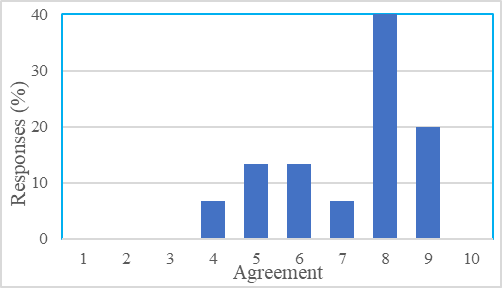 | Figure 1. feel the success of construction project is owned to it is economic performance |
Environmental performance seems to be more evenly spread in terms of the opinion on how much it matters to a project success. Over half the participants were either indifferent or felt it was not important to the success of a project, as shown in Table 3 and Figure 2.Table 3. Feeling the success of construction project is owned to it is environmental performance
 |
| |
|
 | Figure 2. Responses of feeling the success of construction project is owned to it is environmental performance |
Table 4 indicated that, human comfort performance is rated rather highly towards being important towards the success of a project. There were no negative responses and responses of a 7/10 or higher were at over 70% of the participants. High importance is place human comfort a project provides after completion, as shown in Figure 3.Table 4. Feel the success of construction project is owned to human comfort
 |
| |
|
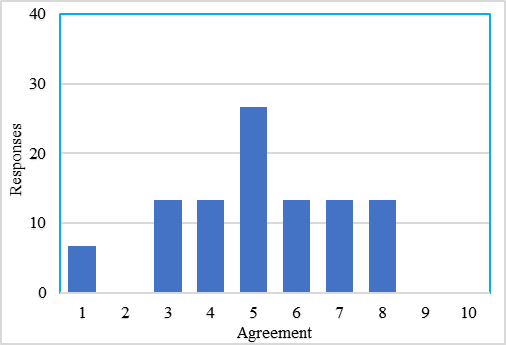 | Figure 3. Agreement of feeling the success of construction project is owned to human comfort performance |
Table 5 discussed the amount people rank their own ability to understand BREEAM has a spread range. With a third of the participants feeling that they have little to no knowledge, over 25% feeling neutral in their understanding, there is a level of lack of clarity for professionals on the details of BREEAM as shown in Figure 4.Table 5. Level of knowledge in BREEAM
 |
| |
|
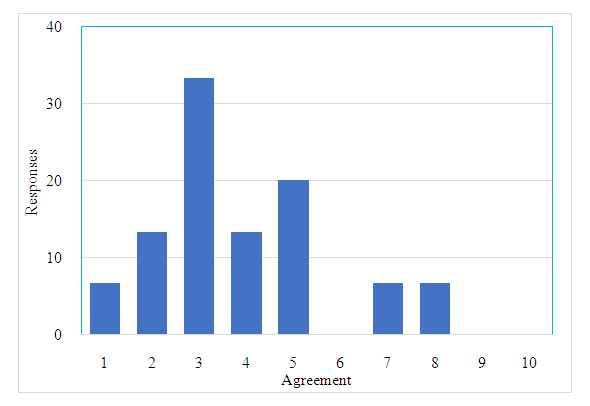 | Figure 4. Level of knowledge in BREEAM |
According to the answering in Table 6 and Figure 5 illustrated that, the residential projects where BREEAM has been implemented for the participants was very low, with nearly 70% rarely working on a residential project that implements BREEAM.Table 6. BREEAM implemented on residential project that you worked on
 |
| |
|
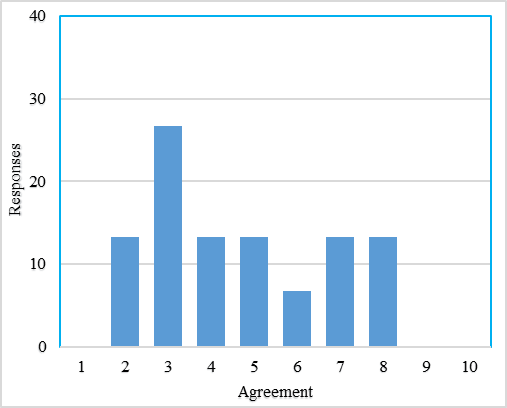 | Figure 5. BREEAM implemented on residential project that you worked on before |
Table 7. explain how numbers of workers who participated in BREEAM projects in different fields. However, in comparison to the residential projects that had BREEAM implemented on them that the participants had worked on, other types of projects see a slight increase in the frequency of BREEAM implemented projects as shown in Figure 6.Table 7. BREEAM implemented any other project that you worked on
 |
| |
|
 | Figure 6. BREEAM implemented on any other project that you worked on |
On Table 8. we can see that, most participants felt the processes required were not affecting the processes for the project, over 60% feeling that the process were either unaffected or made more convenient by BREEAM as shown in Figure 7.Table 8. BREEAM affect the process required to deliver the any other project
 |
| |
|
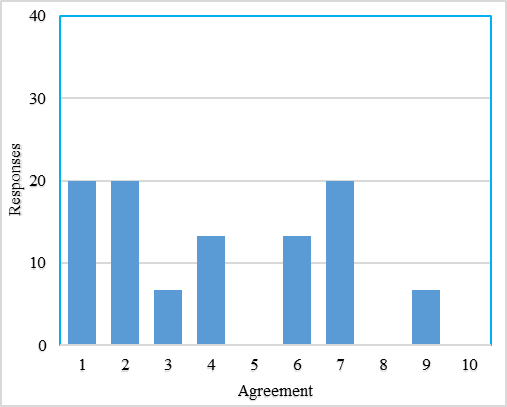 | Figure 7. BREEAM affect the process required to deliver the any other project |
In Table 9. we see a broadly similar pattern in terms of how BREEAM is perceived to be either a nuisance to the processes or a convenience. Nearly 70% felt that the processes were either unaffected of positively influences by BREEAM, number responses explained in Figure 8.Table 9. BREEAM affect the process required to deliver the residential project
 |
| |
|
 | Figure 8. BREEAM affect the process required to deliver the residential project |
Table 10 explain a very balanced opinion here was found with most believing BREEAM had no effect on the success of the project or very little effect according to Figure 9.Table 10. The success could be contributing to BREEAM
 |
| |
|
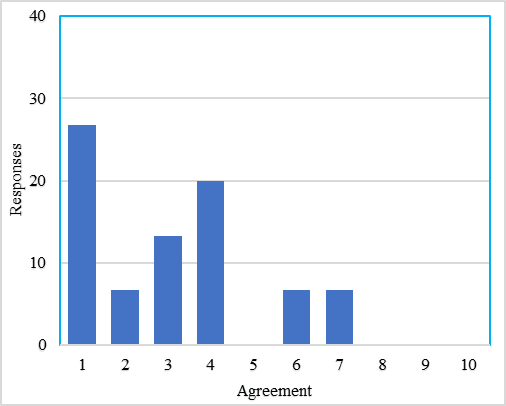 | Figure 9. The success could be contributing to BREEAM |
Table 11 explain a very balanced opinion here was found with most believing BREEAM had low effect on the success of the project or very little effect according to Figure 10. Likewise, with Figure 9, Figure 10 shows that there is little attribution to be made to BREEAM on the success the project had owes to the methodology.Table 11. The success could be contributing to BREEAM in residential projects
 |
| |
|
 | Figure 10. The success could be contributing to BREEAM in residential projects |
Figure 11 illustrated that, highly positive responses with nearly a quarter of respondents agreeing that BREEAM is a good thing for the construction industry. With nearly half feeling it rates an 8/10 for how much they agree that it is a good thing for the construction industry Table 12.Table 12. The success could be contributing to BREEAM
 |
| |
|
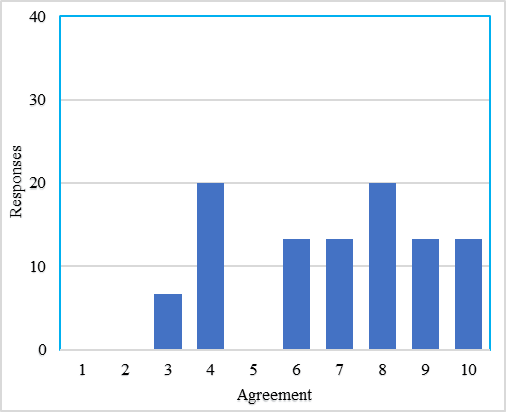 | Figure 11. The success could be contributing to BREEAM |
Table 13 and Figure 12 discussed the effect of usage of BREEAM on residential projects. However, the same cannot be said for its usage on residential projects. Whilst there is a highly positive agreement that BREEAM should be implemented on residential projects, 60% agreed to a high degree that it should be, 20% felt neutral and the remaining 20% seemed to disagree in a highly polarising manner, in stronger disagreement that it should be implemented on residential projects.Table 13. Here we can see the experience range of the participants
 |
| |
|
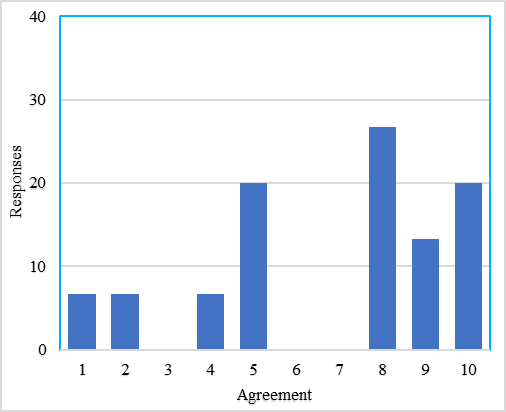 | Figure 12. BREEAM is a good thing for the construction industry |
4. Conclusions
Analysis of both the literature review carried out and the online questionnaire survey can paint a clearer picture on how BREEAM is perceived in the UK construction industry. The results can show how affective the implementation of BREEAM is in a real-life situation based on performance and also highlights the comparison between implementation on a residential project and other project types. It seems that although BREEAM is a highly thought through and potentially powerful tool for combating the challenges faced by sustainable building, it may not perform as expected in the real world. It provides constructors with a framework to stay within and can become a bureaucratic exercise rather than that of sustainable construction. For many it may seem like an inconvenience, a box ticking exercise to appease the system into giving a good score, rather than consider the future of the building’s use with large potentially unnecessary cutting-edge installations. But on the most part BREEAM is a good thing for the construction industry and as a conscience reminder to importance of sustainability in the built environment.
References
| [1] | Cole, R. and Jose Valdebenito, M., 2013, The importation of building environmental certification systems: international usages of BREEAM and LEED. Building Research & Information, 41(6), pp.662-676. |
| [2] | Vimpari, J. and Junnila, S., 2014, Value influencing mechanism of green certificates in the discounted cash flow valuation. International Journal of Strategic Property Management, 18(3), pp.238-252. |
| [3] | Doan, D., Ghaffarianhoseini, A., Naismith, N., Zhang, T., Ghaffarianhoseini, A. and Tookey, J., 2017, A critical comparison of green building rating systems. Building and Environment, 123, pp.243-260. |
| [4] | Parker, J., 2012, The value of BREEAM. Bracknell: BSRIA Ltd. [Online] Available: https://tools.breeam.com/filelibrary/BREEAM%20and%20Value/The_Value_of_BREEAM.pdf. |
| [5] | Holmes, J. and Hudson, G., 2003, The application of BREEAM in corporate real estate: A case study in the design of a city centre office development. Journal of Corporate Real Estate, 5(1), pp.66-77. |
| [6] | Schweber, L., 2013, The effect of BREEAM on clients and construction professionals. Building Research & Information, 41(2), pp.129-145. |
| [7] | Lowe, Jack and Watts, Norman, 2011, An evaluation of a Breeam case study project. Sheffield Hallam University Built Environment Research Transactions, 3 (1), 42-53. |
| [8] | BRE, 2014. The Digest of BREEAM Assessment Statistics Volume 01, 2014. BRE Global Ltd. |
| [9] | Shibani, A., Hassan, D., and Shakir, N., 2020, The Effects of Pandemic on Construction Industry in the UK, Mediterranean Journal of Social Sciences, 11(6), 48. https://doi.org/10.36941/mjss-2020-0063. |















 Abstract
Abstract Reference
Reference Full-Text PDF
Full-Text PDF Full-text HTML
Full-text HTML











